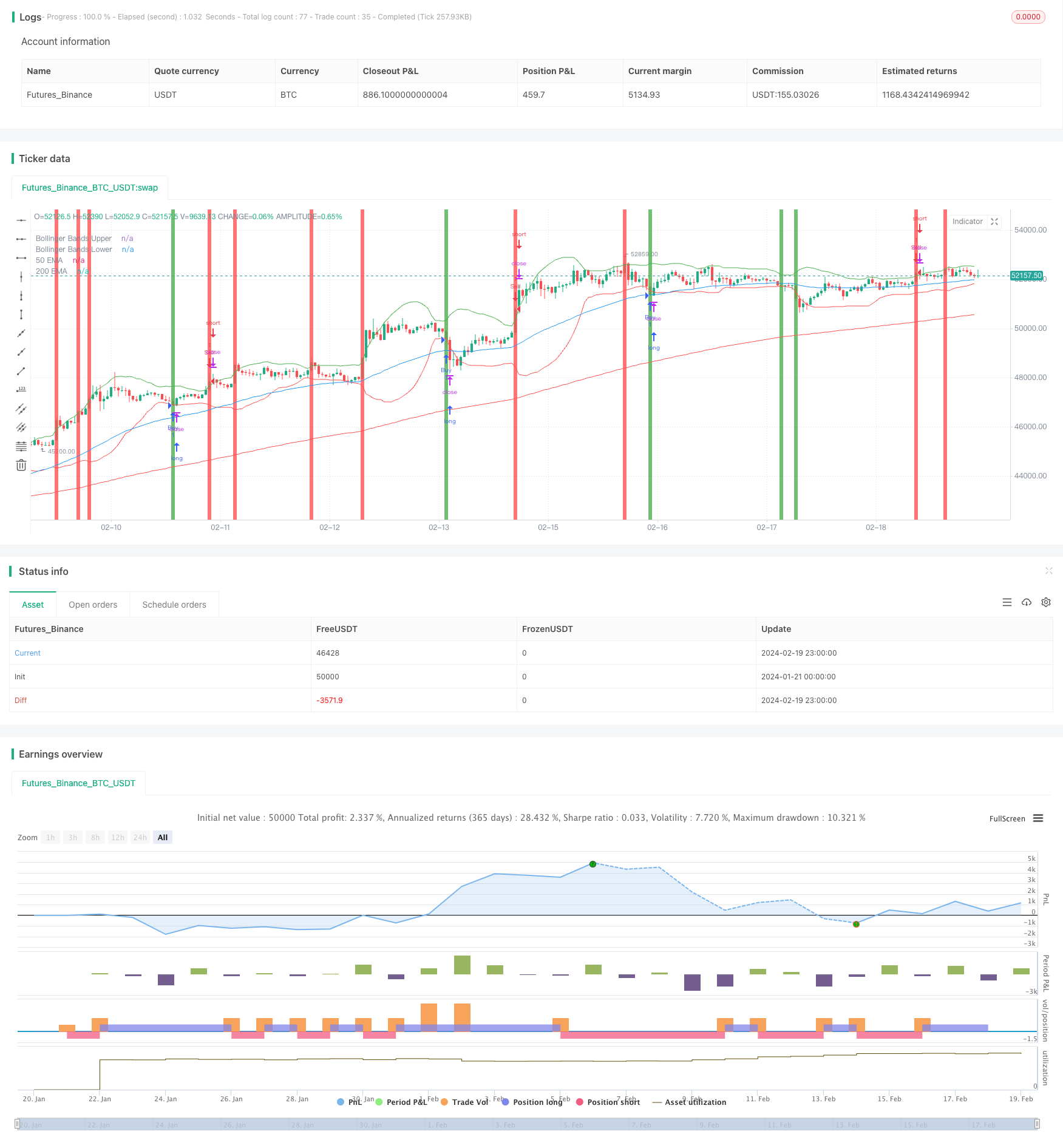
概述
该策略通过计算两条不同周期的EMA均线,判断股价的长期和短期趋势;同时结合布林带上下轨,判断股价是否处于超买或超卖状态,作为入场和出场的信号。它综合运用均线、布林带等多种技术指标,判断市场的反转点,属于典型的趋势跟踪与反转交易策略。
策略原理
- 计算快速EMA(50周期)和慢速EMA(200周期),快速EMA上穿慢速EMA为做多信号,快速EMA下穿慢速EMA为做空信号
- 计算20周期的布林带上轨和下轨
- 当价格突破布林带上轨时,视为超买信号,做空;当价格跌破布林带下轨时,视为超卖信号,做多
- 综合EMA均线的金叉/死叉信号和布林带的突破信号,判断入场和出场点
以上是该策略判断买卖点的主要方法。当快速EMA上穿慢速EMA,或股价跌破布林带下轨时,做多;当快速EMA下穿慢速EMA,或股价突破布林带上轨时,做空。
优势分析
这是一个典型的多种技术指标组合使用的策略,综合考虑了股价的长短期趋势和超买超卖状态,有以下主要优势:
- 均线的金叉死叉,可以有效判断长短期趋势
- 布林带可以判断价格的超买超卖区域,防止追高杀跌
- 组合多种指标,系统性强,避免假信号
- 回测效果可以通过参数优化而得到改进
风险分析
该策略也存在一些风险:
- EMA均线生成延迟,可能错过最佳入场点
- 布林带宽度参数选取不当,可能错过趋势
- 多种信号组合,增加了策略复杂度
- 因특定市场环境变化,参数不再适用
对策: 1. 优化参数,适应市场环境 2. 增加止损策略,控制风险 3. 测试不同的EMA和布林带参数组合 4. 策略可以进一步优化,如结合RSI等指标
优化方向
该策略具有很强的优化空间:
- EMA和布林带的参数可以测试更多的组合
- 可以加入MACD,KDJ,RSI等其他指标进行组合
- 增加尾随止损策略
- 可以测试在不同的时间周期(60分钟,日线等)运行策略
- 可以结合交易量的异常来发现更多交易信号
通过测试不同的参数和指标,对策略进行充分的回测和优化,可以进一步提高策略的稳定性和盈利能力。
总结
该策略基于EMA均线和布林带这两个最重要的技术指标,判断股价的长短期趋势和超买超卖区域,具有较强的实用性。通过参数优化和组合更多指标,可以获得更好的策略效果。该策略很好地体现了量化交易策略的思路,即评估市场环境,设计规则,并优化策略。相信通过不断测试和改进,该策略可以成为一个可靠稳定的量化交易策略。
策略源码
/*backtest
start: 2024-01-21 00:00:00
end: 2024-02-20 00:00:00
period: 1h
basePeriod: 15m
exchanges: [{"eid":"Futures_Binance","currency":"BTC_USDT"}]
*/
//@version=4
strategy("Reversal Patterns, EMA Crossover, and Bollinger Bands", shorttitle="RP-EMABB", overlay=true)
// Input parameters
emaShortPeriod = input(50, title="Short EMA Period", minval=1)
emaLongPeriod = input(200, title="Long EMA Period", minval=1)
bbLength = input(20, title="Bollinger Bands Length", minval=1)
bbMultiplier = input(2.0, title="Bollinger Bands Multiplier", minval=0.1, maxval=5.0)
// Calculate EMAs
emaShort = ema(close, emaShortPeriod)
emaLong = ema(close, emaLongPeriod)
// Calculate Bollinger Bands
bbUpper = sma(close, bbLength) + bbMultiplier * stdev(close, bbLength)
bbLower = sma(close, bbLength) - bbMultiplier * stdev(close, bbLength)
// EMA Crossover and Crossunder
emaCrossover = crossover(emaShort, emaLong)
emaCrossunder = crossunder(emaShort, emaLong)
// Bollinger Bands Crossing
bbUpperCross = crossover(close, bbUpper)
bbLowerCross = crossunder(close, bbLower)
// Buy and Sell signals
strategy.entry("Buy", strategy.long, when=emaCrossover or bbLowerCross)
strategy.entry("Sell", strategy.short, when=emaCrossunder or bbUpperCross)
// Plot EMAs on the chart
plot(emaShort, color=color.blue, title="50 EMA")
plot(emaLong, color=color.red, title="200 EMA")
// Plot Bollinger Bands
plot(bbUpper, color=color.green, title="Bollinger Bands Upper")
plot(bbLower, color=color.red, title="Bollinger Bands Lower")
// Highlight Buy and Sell signals on the chart
bgcolor(emaCrossover or bbLowerCross ? color.green : na, transp=90)
bgcolor(emaCrossunder or bbUpperCross ? color.red : na, transp=90)